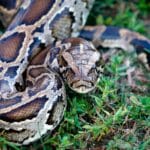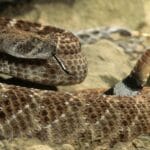Uncoiling the Secrets of Pythonidae: An In-Depth Exploration of the World’s Most Captivating Snakes
Let’s venture into the tantalizing world of snakes known as Pythonidae! These non-venomous charmers come in all shapes and sizes, from the tiny Anthill Python, which is only two feet long, to the jaw-dropping Reticulated Python, which can stretch over 20 feet! Get ready to uncover the secrets behind their incredible abilities, like heat-sensing pits that help them hunt in the dark and super-flexible jaws that allow them to swallow huge animals whole. Join us on an unforgettable expedition into the captivating realm of pythons, where every twist and turn is filled with wonder and fascination.
Unveiling the Allure of Pythons
Pythons: often associated with immense size and strength. While true, these incredible creatures are far more than just their imposing presence. They are non-venomous snakes, members of the Pythonidae family, thriving in the tropical regions of Africa, Asia, and Australia.
What sets pythons apart are their heat-sensing pits, allowing them to “see” the body heat of their prey, even in darkness. This remarkable adaptation makes them highly effective hunters.
However, these skilled predators face mounting challenges. Habitat destruction and hunting for their skins threaten their populations. Therefore, understanding these fascinating creatures and supporting conservation efforts is crucial.
From the familiar Burmese python to the elusive Borneo short-tailed python, the Pythonidae family is full of diversity. Each species showcases unique appearances, behaviors, and adaptations perfectly suited to their environment.
Let’s delve deeper into the world of pythons and uncover their secrets.
Python Essentials: Classification and Anatomy
- Family: Pythonidae
- Venomous?: No
- Habitat: Tropical regions of Africa, Asia, and Australia
- Diversity: Approximately 10 genera and 39 species
Built for Power:
- Size: Highly variable, from the small ball python to the massive reticulated python.
- Heat-Sensing Pits: Act as infrared detectors, enabling hunting in darkness.
- Hook-like Teeth: Sharp and curved backward for secure prey capture.
- Flexible Jaws: Allow swallowing prey larger than their heads.
Ambush Predators: The Art of the Hunt
- Masters of Patience: Pythons are ambush predators, relying on camouflage and surprise.
- The Constriction Technique: Once they strike, they coil around their prey, tightening their grip with each exhale, leading to cardiac arrest.
- Diverse Palate: Their diet consists of rodents, birds, reptiles, and mammals, with larger pythons capable of taking down deer.
Python Families: A Legacy of Care
- Egg Layers: Pythons are oviparous, laying eggs instead of giving birth to live young.
- Dedicated Mothers: Females coil around their eggs, providing warmth and protection, even shivering to generate heat.
Pythons and Humans: A Complex Relationship
- Conservation Concerns: Habitat loss and hunting for the pet trade threaten numerous python species.
- Protection Efforts: International laws, like CITES, regulate trade, while conservationists promote responsible pet ownership.
- Pythons as Pets: While fascinating, pythons require extensive care and commitment. Thorough research is essential before acquiring one.
Mysteries Yet to Be Unraveled
Our understanding of pythons continues to evolve. Scientists are constantly making new discoveries about their behavior, biology, and ecological roles. The world of pythons remains an exciting frontier of exploration and discovery.
Outperforming the Competition: Is a Python’s Bite Poisonous?
Myth Busted: Pythons are non-venomous constrictors, subduing prey through powerful squeezing, not injecting venom.
A Python Bite Can Hurt, but It Won’t Poison You. While not venomous, python bites can be painful and require medical attention due to their sharp teeth and the risk of infection.
Size Matters: Larger pythons pose a greater threat than smaller species. While a bite from a small python might be comparable to a cat scratch, larger pythons can inflict serious wounds with their powerful jaws.
Respect, Don’t Fear: Understanding python behavior is key to safety. Pythons are generally not aggressive towards humans and will only bite defensively. Learning about their behavior can help prevent dangerous encounters.
Discover the vibrant world of the psittacidae birds, known for their remarkable intelligence and colorful plumage. Immerse yourself in the captivating beauty of the queen alexandra’s birdwing, the largest butterfly in the world, with breathtaking wings adorned with vibrant colors and intricate patterns.
















1 thought on “Uncoiling the Secrets of Pythonidae: An In-Depth Exploration of the World’s Most Captivating Snakes”
Comments are closed.